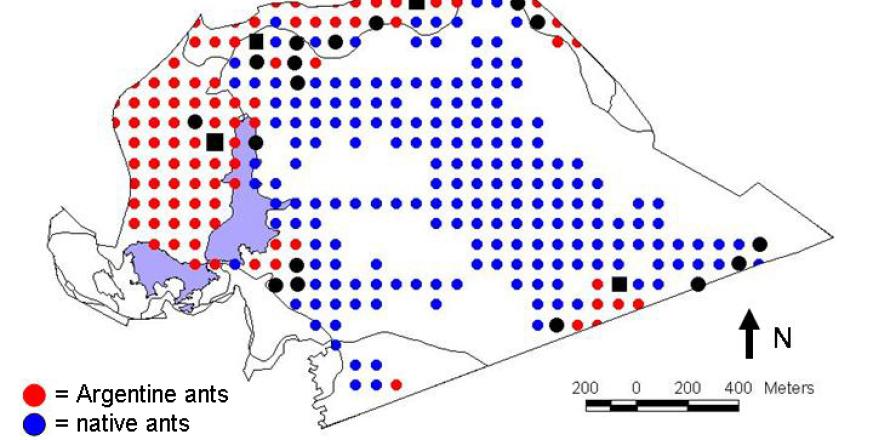Longterm study of invasion by Argentine ants, Linepithema humile

Summary
Argentine ants are an invasive species worldwide and have invaded roughly a third of JRBP from disturbed areas near the Preserve's perimeter. Since 1993, students, postdocs, and other affiliates in Prof. Deborah Gordon's lab have monitored the invasion every May and September by censusing survey points on a 100m grid throughout the accessible parts of the Preserve. The survey consists of recording all species of ants observed within a 20m radius of the survey points. A large number of volunteers contribute to the survey; some have participated for years.
Every census has detected the invasion of some new hectares, but retreats have also occurred, and the greatest number of hectares was occupied in 1999. Students have also studied the mechanisms and consequences of the invasion. Collectively their work is the first systematic study of interactions between Argentine ants and local species along expanding margins of the Argentine ants' range.
Results from the Gordon lab challenge two prevailing theories for the ants' success as invaders. One theory held that Argentine ants became invasive outside their native habitat because they lost behaviors--especially agression toward other nests of Argentine ants--that limited their ability to displace other ant species. However, work by Nicole Heller discovered that Argentine ants tend to be uni-colonial both in California and in Argentina, occupying multiple interconnected nests in both regions without significant differences in aggressive interactions. A second theory was that the invasiveness is related to genetic homogeneity among the ants, leading to one enormous supercolony in California. Postdoctooral scholar Krista Ingram discovered, however, that significant genetic differences occur between nests as near to one another as those in the SLAC corridor and those across the Sand Hill Road boundary of JRBP. In studying the 28-year record of Argentine and other ants at Jasper Ridge, doctoral student Lisa Couper and other researchers found that Argentine ant distriubtion shrank following the 2012-15 drought whereas some (but not all) native ants expanded in distribution during the same period.
Project Location (Sectors 11, 12, 13, 14, 15, 16, 20, 21, 22, 23, 24, 25, 29, 30, 31, 32, 33, 34, 35, 36, 40, 41, 42, 43)
 |  |  |  |  |  |  |  |  |
 |  |  |  |  |  |  |  |  |
 |  |  |  |  |  |  |  |  |
 |  |  |  |  |  |  |  |  |
 |  |  |  |  |  |  |  |  |
 |  |  |  |  |  |  |  |  |



